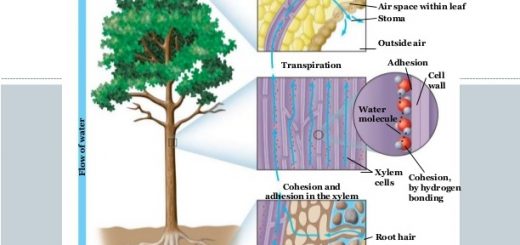Fetal membrane layers, Chorion, Amnion, Yolk sac and umbilical cord
Fetal membranes are all the membranes that develop from the zygote and they do not share in the formation of the embryo (extraembryonic structures from the primitive blastomeres). Fetal membranes are Chorion, Amnion, Yolk sac, the umbilical cord including allantois and body stalk.
Yolk sac development
Yolk sac is formed in the ventral aspect of the embryonic disc (primitive yolk sac or exo-coelomic cavity). the roof of the yolk sac is formed of the endodermal layer of the embryonic disc. The remaining part of the primitive yolk sac is lined by flattened cells formed from the endodermal layer of the embryonic disc, covered by the extra-embryonic mesoderm.
Later on, due to the growth of the embryo, the primitive yolk sac is reduced in size and transformed into the secondary yolk sac (formed of endoderm surrounded by a layer of splanchopleuric primary mesoderm), the blood vessels are formed in this mesoderm known as vitelline arteries & veins.
After folding: The gut is formed as a result of folding of the embryo. Thus part of the yolk sac is taken inside of the embryo (the intra-embryonic portion of the yolk sac). This forms the foregut, midgut & hindgut. The midgut communicates with the extraembryonic part of the yolk sac by the yolk stalk.
The growth of the embryo and the intestinal tract leads to a reduction in the size of the yolk stalk (the vitellointestinal duct). This duct is lodged in the umbilical cord and later on, it atrophies and disappeared completely.
Fate of the yolk sac
- Formation of the mucosal lining of the gastrointestinal tract.
- The allantois develops from the dorsi-caudal part of the yolk sac. after folding it is shifted ventrally and enclosed in the umbilical cord. It is then obliterated forming the urachus, the urachus fibrosed to form the median umbilical ligament.
- The yolk stalk is formed as a constriction of the yolk sac, it connects the midgut to the extraembryonic part of the yolk sac. This stalk enclosed into the umbilical cord, later on, it is obliterated and disappeared completely.
Functions of the yolk sac
- Formation of the mucosa of the alimentary canal and respiratory system.
- Formation of the blood corpuscles.
- Vitelline vessels will give the superior mesenteric artery, portal, and hepatic veins.
- Some cells from the wall of the yolk sac (endoderm) migrate to the caudal end of the embryo. These cells are called the (primordial germ cells) which will form the gametes (sperms & ova).
- Formation of the major part of the urinary bladder and urethra.
- Formation of the umbilical blood vessels by the mesoderm surrounding the allantois.
Abnormalities of the yolk sac
- Congenital umbilical fecal fistula is due to the persistence of the vitello-intestinal duct leading to abnormal communication between the intestine (midgut) and the umbilicus. It leads to the discharge of feces from the umbilicus.
- Meckel’s diverticulum occurs due to the patent intestinal end of the vitello-intestinal duct. The rest of the duct is degenerated or obliterated forming a fibrous band. Meckel’s diverticulum is a blind pouch about 3-6 cm (2 inches) long that arises from the antimesentric border of the ileum, two feet from the iliocaecal junction. It occurs in 2-4 % of people and is 3-5 times more prevalent in males than females. It might contain gastric mucosa which leads to its ulceration. Sometimes it becomes inflamed and causes symptoms like that caused by appendicitis.
- Congenital umbilical sinus is due to patent umbilical end of the vitello-intestinal duct.
- Fibrous band: Obliteration of the yolk stalk occurs but it remains as a fibrous band. Intestinal obstruction may occur as a complication.
- Vitelline cyst: Both ends of the vitello-intestinal duct close leaving an intermediate potion patent forming a cyst.
Allantois
- It is as a diverticulum from the caudal end of the yolk sac (cloaca after folding), it is endoderm in origin. It is embedded into the mesodermal body stalk.
- The primary mesoderm covers it forms the umbilical blood vessels.
- Later, it degenerates leaving a remnant called the urachus that extends from the apex of the urinary bladder to the umbilicus. After birth, it is fibrosed to form the median umbilical ligament.
Congenital anomalies of the allantois
- Urachal fistula: the urachus fails to obliterate. It leads to urine discharge from the umbilicus due to its connection to the urinary bladder.
- Urachal sinus: the proximal part of the urachus (part near the umbilicus) remains patent, while the rest of the urachus is obliterated.
- Urachal cyst: the middle portion of the urachus remains patent, the rest is obliterated.
Amnion and amniotic fluid
Amnion is a membrane that bounds the amniotic cavity. It is continuous with the ectoderm of the embryo. The amniotic cavity contains about 800-1000 ml of watery and clear fluid at the full-term fetus.
Development of the amnion
A small cavity appears within the epiblast layer of the inner cell mass (ectodermal layer) called the amniotic cavity. The cells of the epiblast (ectoderm) adjacent to the cytotrophoblast are called amnioblasts. The amnioblasts (amniotic membrane) from the roof of the amniotic cavity, the ectodermal layer of the embryonic disc forms the floor of the cavity.
The amniotic cavity filled with amniotic fluid, it increases in size, the layer of the amnioblasts loses its contact with the inner surface of trophoblast and become known as the amnion. After folding the amnion surrounds the embryo from all directions. It increases in size on the expense of extraembryonic coelom until the coelom is obliterated, this leads to a fusion between the somatopleuric primary mesoderm lines the amnion with that lines the inner aspect of trophoblast.
Sources of amniotic fluid
It is formed mainly of water. It comes from two sources:
- Maternal source, from the diffusion of fluid from the uterine endometrium.
- Fetal source, from urine, feces (meconium), and respiratory secretion of the embryo.
Clinical uses of the amniotic fluid
The cells, DNA, enzymes, and protein in the amniotic fluid can be used to diagnose chromosomal anomalies of the embryo, e.g. Down syndrome.
Functions of the amniotic fluid
I- During pregnancy:
- The fluid allows free growth and movements of the fetus, absorb external trauma and prevents adhesions between the embryo and amnion.
- Swallowing of the amniotic fluid stimulates the fetal suckling reflex.
- It maintains a constant temperature around the fetus.
- It permits the normal development of the fetal lung.
- It maintains a normal balance between fetal fluid and electrolytes (fetal homeostasis).
II. During labour:
- It forms the bags of fore water and hind water, the bag of fore water allows regular dilatation of the cervix and cleans the female passages before labor.
- After rupture of the membrane, the amniotic fluid serves as a lubricant to facilitate the descent of the fetus.
- The amniotic fluid is bacteriostatic to the female genital system.
Abnormalities of the amniotic fluid
- Oligohydramnios: The amniotic fluid is less than 400 ml. It may lead to adhesions between the fetus and its amnion. It is associated with renal agenesis of the fetus.
- Polyhydraminos: The amniotic fluid is 1500-2000 ml at birth. It is associated with esophageal atresia of the fetus or diabetes mellitus of the mother. Polyhydraminos may cause premature labour.
- The embryo may be delivered without rupture of the amniotic sac, the fetus born surrounded by the amnion, this condition called caul du sac.
The umbilical cord
It is the area of communication between the fetal surface of the placenta and embryo after folding. The structures forming the primitive umbilical cord:
- Yolk stalk and the vitelline blood vessels.
- The ectoderm of the amnion.
- Body stalk (extraembryonic mesoderm).
- Allantois (endoderm).
- Part of the extraembryonic coelom. The small intestine (midgut loop) normally herniates in this extraembryonic coelom. In the 10th week, the intestine is reduced back into the abdominal cavity and the extraembryonic coelom is obliterated to prevent re-herniation of the intestine.
- Umbilical blood vessels.
Fate of body stalk
It forms the jelly of Wharton of the definitive umbilical cord.
Fate of yolk sac stalk
- It is a narrow space connecting the midgut with the extraembryonic yolk sac and contains the vitelline vessels.
- Later on, it is obliterated and disappeared; the vitelline arteries will form the artery of the midgut (superior mesenteric artery).
Fate of allantois
- It is a small blind-ended pouch arising from the hindgut and invades the body stalk.
- The primary mesoderm around it forms the umbilical blood vessels.
- The allantois obliterated forming the urachus, after that, it transformed into median umbilical ligament.
Structures of the definitive umbilical cord at birth
- It is 30-90 cm long (average is 55 cm) and 2 cm in diameter.
- It is spirally twisted due to the long 2 umbilical arteries compared to the relatively short umbilical vein, this leads to the appearance of false knots.
- It is shiny because it is covered by the amnion.
- Contents: Wharton’s jelly-2 umbilical arteries and single left umbilical vein-allantois (urachus) – the remnant of the vitello-intestinal duct and remnant of the extraembryonic coelom.
- It is attached to the center of the placenta.
Postnatal changes in the umbilical cord
- The two umbilical arteries are obliterated and transformed into the two medial umbilical ligaments.
- The left umbilical vein is transformed into the ligamentum teres of the liver.
- The allantois is obliterated and transformed into the median umbilical ligament.
Abnormalities of the umbilical cord
- Long umbilical cord: This may lead to cord prolapse or the cord may encircle the neck of the fetus causing fetal strangulation.
- Short umbilical cord: This might cause premature separation of the placenta or rupture of the cord during delivery or may cause inversion of the uterus of the mother.
- A large part of the small intestine covered with membrane may remain herniated in the cord (fails to return to the fetal abdominal cavity) leading to omphalocoele (exomphalos). Therefore, the cord should be ligated away from the umbilicus to avoid ligation of the intestine in the ligature.
- Double or triple cord.
- A cord with true knots (occurs in about 1% of pregnancies, this leads to obliteration of umbilical blood vessels.
- Velamentous attachment to the placenta (the umbilical cord does not reach the placenta and the umbilical blood vessels run along the amnion to the placenta.
- Marginal attachment of the cord to the placenta this is called battle-dore placenta.
- Single umbilical artery. It occurs due to genetic causes. Its incidence is about one in 200 newborns.
- Congenital umbilical hernia, in this anomaly a small part of the intestine herniates through the umbilicus of the newborn, this herniated structure is covered with skin, it is due to the weakness of the anterior abdominal wall.
Productive organs, Germ cells, Fertilization, Stages of cleavage, Implantation & Decidua
Second & third week of Embryonic development, Chorion & types of Chorionic villi
Third to eight weeks (Embryonic period), Embryo Folding & Results of folding
Placenta types, structure, function, development & abnormalities



